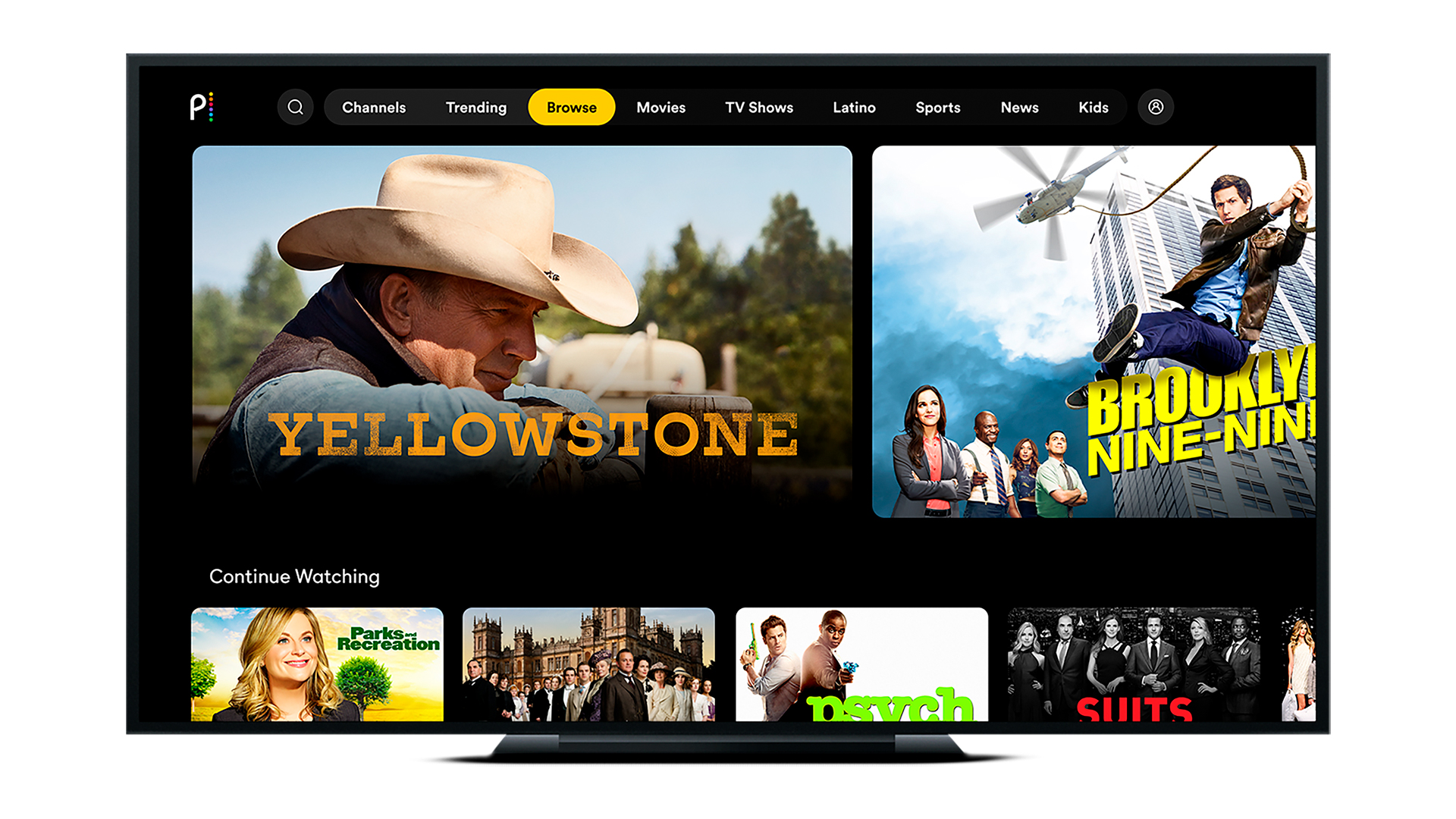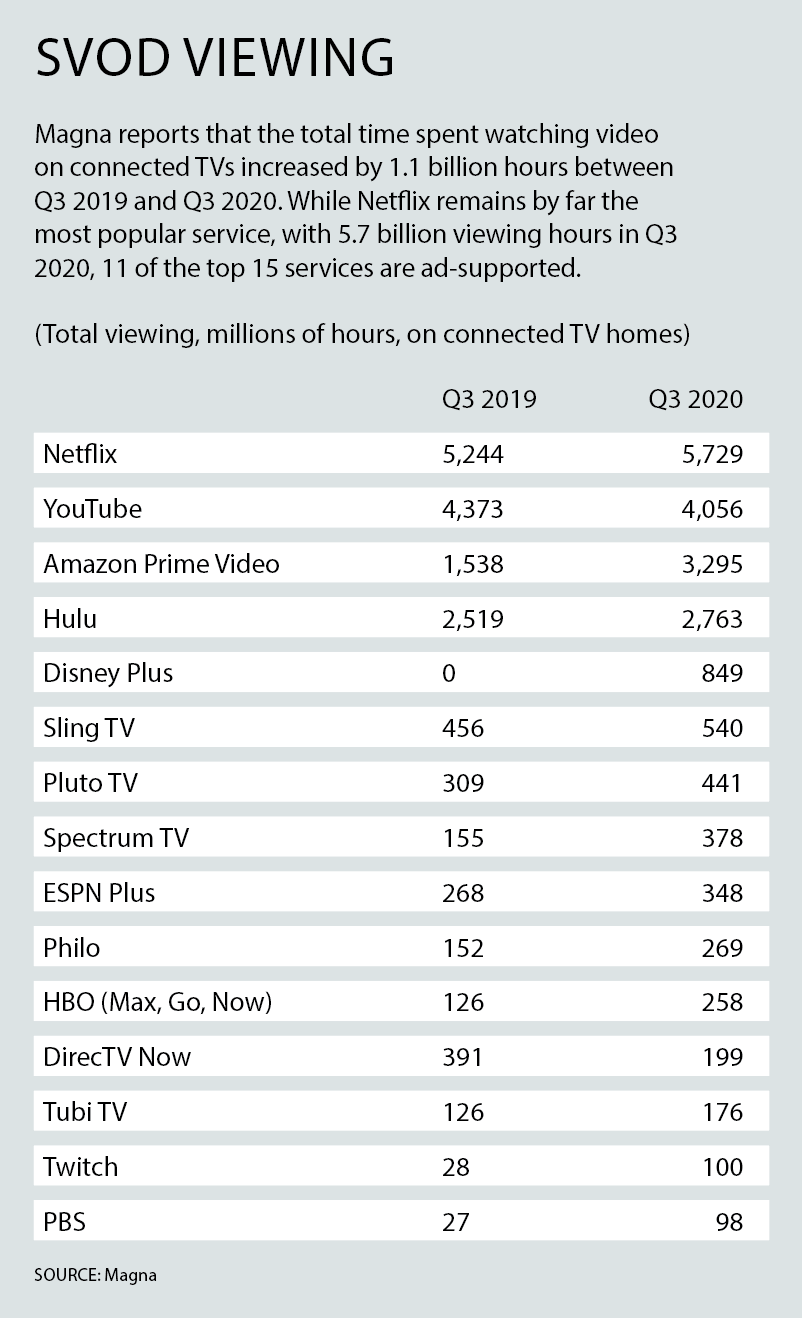More Streaming, More Uncertainty
Everyone has embraced the video revolution. Now what?

If the TV industry remembers 2020 as a year of COVID-19 carnage and political turmoil that brought the streaming evangelists firmly to power, 2021 promises to be the year of both growth and uncertainty.
“All major media companies are all in on streaming,” Scott Rosenberg, Roku senior VP and general manager of the platform business, noted. “They have finally really started to change their focus and invest in their streaming experiences. It’s a real transformation, because everyone now knows very clearly that all TV is going to be streamed and that pay TV linear world is on the decline.”
One example of that transformation can be found at The Walt Disney Co. “We are investing heavily to create the highest quality content for direct-to-consumer” services, said Justin Connolly, president, Disney Platform Distribution. “The commitments we’ve made — of billions of dollars of spending on great content — are translating into engagement, time spent and success.”
For instance, Connolly noted, Disney Plus, Hulu and ESPN Plus have already beaten their combined subscriber targets set for 2024, years earlier than expected, with 137 million paid subscribers in December of 2020. Disney now predicts the three services will hit 300 million to 350 million subscribers by 2024.
Similar optimism can be found at NBCUniversal’s Peacock, AT&T-owned HBO Max and Discovery, which just launched Discovery Plus.

“One of reasons we are so excited to be launching Discovery Plus is that we’ve seen explosive growth in streaming in the last five years,” Karen Leever, president of U.S. digital products and marketing for Discovery, said of the subscription VOD service that launched Jan. 4. “For a large population, it is the only way they know how to consume video and we are ready to tap into it.”
“Ten years from now, you are going to have some number of services that are global services with hundreds of millions of subscribers,” added Andy Forssell, executive VP and general manager of WarnerMedia Direct-to-Consumer, which believes HBO Max will be one of those SVOD giants.
Multichannel Newsletter
The smarter way to stay on top of the multichannel video marketplace. Sign up below.
But Forssell, Connolly and many of the 27 industry executives and researchers interviewed for this year’s Viewer Watch report also predicted 2021 will bring a great deal of uncertainty as the major players experiment with various streaming-era business models.
“The road map for digital and streaming and the media business is less clear than it was in the past, because there is so much disruption industry-wide at the big players,” CBS News Digital executive VP and general manager Christy Tanner said.
Tanner said she thinks trusted brands like CBS News should thrive in the new streaming landscape, noting that the seismic shift toward streaming and DTC video has already boosted CBS News and other news operations. The 24-hour streaming news channel CBSN surpassed 1 billion streams in 2020, a new peak for the service.
The massive shift towards streaming can also be seen at Roku, which has more than tripled its active accounts from 15.1 million at the end of Q2 2017 to 46 million in third-
quarter 2020, when those users streamed about 14.1 billion hours of content.
“Our research shows that the number of homes that are consuming OTT content was up by 3.6 million in 2020, year over year,” Carol Hinnant, chief revenue officer of measurement service Comscore, said. “We’ve also seen that households are consuming an extra 18 hours a month of OTT content year over year. That is a lot of incremental viewing.”

The Future of Everything
Behind the soaring numbers, many questions remain, ranging from the future of pay TV platforms and advertising in the emerging streaming landscape to how movies and other content will be financed in an environment where many blockbuster films and big-budget TV series are streaming directly to consumers.
“Direct-to-consumer is a seismic shift in the focus of the industry, especially when you look at movies,” Comscore’s Hinnant said, disrupting longstanding business models for financing, distributing, marketing and monetizing programming.
Given that revolutions have a propensity to be self-destructive and to turn in unexpected directions, the disruption will at minimum involve shifts in billions of dollars in revenue.
Big media-buying firm Magna predicts that pay TV subscribers will drop from 93.4 million in 2019 to 67.3 million in 2024, while PwC estimates that the money spent on traditional pay TV subscriptions will decline from $89.6 billion in 2019 to $79.6 billion in 2024, a $10 billion drop in revenue. Magna is also predicting that total TV advertising will fall from $60.8 billion in 2019 to $51.2 billion to 2024.
That adds up to a $19.6 billion decline in traditional TV advertising and subscription revenue in the next four years, a major hole that TV companies will look to fill with new business.
On the other side of the financial ledger, Magna says digital video advertising is expected to grow to $25 billion in 2024 from $14.3 billion in 2019, a $10.7 billion jump. Total over-the-top video revenue from subscriptions and content sales or rentals will increase to $30.9 billion from $18.2 billion, a $12.7 billion rise, according to PwC.
More good news comes from the broadband sector, where cable operators, telcos and cellphone operators will look to capitalize on the rise of internet access spending to $216.1 billion in 2024 from $172.4 billion in 2019, creating a new $43.7 billion pot of gold, according to PwC.
The $67 billion in new revenue from just those three sectors — digital video advertising, OTT and internet access — provides an obvious explanation for the widespread optimism among industry executives.
But the battle to win a share of that $67 billion pie and the struggle to avoid being crippled by the $19.6 billion decline in the pay TV industry also goes a long way toward explaining the uncertainty facing many companies.

Bigger Is Better
“This isn’t going to be a year where you can wait and see what happens,” Magid VP, digital research and strategy Andrew Hare said. “Consumers are making their minds up for the long term right now. The next five years will be incredibly critical for the future of these companies.”
To succeed, the larger players will have to build scale with hundreds of millions of subscribers if they want to cover massive spending on content and tech infrastructures. “That is why there is an absolute war going on for subscriptions and scale,” PwC U.S. technology, media and telecommunications partner Gregory Boyer said. “They have to have scale, and they know that if they miss the window for achieving it, it may be too late.”
That imperative has precipitated an arms race in content spending. Netflix, the current market leader, could spend more than $19 billion on video content in 2021, according to the financial comparison site Bankr, up from $17.3 billion in 2020.
Meanwhile, Disney has said it intends to spend from $14 billion to $16 billion on global content for direct-to-consumer services by its fiscal 2024.
“HBO and HBO Max’s total content budget might amount to $6 billion to $7 billion in 2021,” GroupM global president of business intelligence Brian Wieser noted in a December blog post, while “Amazon and Apple have demonstrated a willingness to invest mid-single-digit billions of dollars or more in annual content production or licensing fees.”
In addition to making massive investments in SVOD content, the studios were taking more content directly to consumers. Some of this was prompted by theater closures during the pandemic, but Warner Bros. has taken the controversial step of announcing that its entire 2021 movie slate will debut both in theaters and on HBO Max.
“If that continues, it completely changes the entire industry,” Leichtman Research Group president and principal analyst Bruce Leichtman said. “It changes the budgets, the marketing, the revenue. Even if the window just shrinks [from the 100-day theatrical window to 30 days] before movies go direct-to-consumer, it changes the entire value chain.”
This massive investment in direct-to-consumer content also has some serious implications for the future of advertising, Wieser noted in an interview, as major content producers shift production budgets to SVOD services that currently carry little or no advertising.
“The accelerated investment in direct-to-consumer services will lead to consumers reducing their time on linear TV, making it harder for advertisers to reach consumers,” he said.
Michael Leszega, manager of market intelligence at Magna, agreed. “As more people cut the cord, what that means on linear TV is an increasingly older demo,” he noted. “The technology, toy and movie industries in particular will be forced to leave national TV. How will toy marketers reach kids on TV if they are watching ad-free SVOD services?”

Change or Die
Such pressures are producing a wave of innovation in both advertising and pay TV.
NBCU is using direct-to-consumer service Peacock to rethink the efficacy of advertising. “Historically, advertisers have spent a good portion of their budgets on linear TV,” Rick Cordella, executive VP and chief revenue officer for Peacock, said. “But linear TV viewing is now being shifted to streaming outlets and many of them are ad-free. So we are hoping to offer those advertisers a great landing spot on Peacock, where we can target those ads to the right customers and give them a much better ROI to marketers.”
Operators are also making some radical changes in the way they package services, with some encouraging results.
“Generally speaking, we want to offer more choice and flexibility to our customer when it comes to how and where they can consume video,” said Jodi Robinson, senior VP of digital platforms at Charter Communications, which bucked cord-cutting trends by adding 67,000 video subs in the third quarter of 2020.
For instance, cable operators have shown a willingness to add subscription VOD content to the traditional pay TV offering, further blurring lines between cable and streaming platforms. Comcast has added access to Netflix, Hulu, Peacock and others to various TV packages.

“We just recently announced the intent to bring Disney Plus and ESPN Plus to Comcast’s set-top boxes, which will happen in the first calendar quarter in 2021,” Disney’s Connolly said.
CuriosityStream, an SVOD service offering factual and documentary content, has also seen increased interest from cable operators, said chief product officer and executive VP content strategy Devin Emery. “Altice USA bought a subscription to CuriosityStream for everyone who gets the internet through them,” Emery said.
Likewise, Discovery’s Leever noted that Discovery Plus is available on Verizon, “bundled across their mobile and TV subscription services, and you’ll see other partnerships, whether it is with an MVPD or another tech partner.”
“There is a continued appetite for more choice and content in what [customers] choose to consume,” said Kristine Faulkner, senior VP of marketing operations for Cox Communications, which has added many SVOD services to its lineups. “But [subscribers] also want easier search and discovery because there has been a deluge of content. So we’re curating content and providing tools,” such as voice control and universal search across SVOD and linear cable content, “to make some of those options easier.”
The next article will look at how all of these trends are redefining long-established TV industry business models and strategies.
